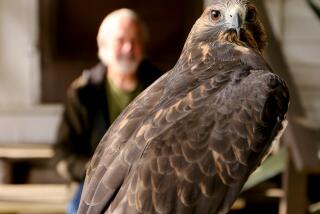Homes, Food Supply Lost : Trappers Race Dozers to Save Foxes at Plant
- Share via
A wild red fox displaced by bulldozing at the Los Angeles Hyperion Treatment Plant in Playa del Rey has been captured and given a new home.
But another fox was not so lucky. Louis Dedeaux, wildlife specialist with the Animal Care and Control Division of the Los Angeles Regulation Department, said the second fox, captured a day later, was in such poor condition because of the loss of its home and food supply that it had to be destroyed.
“It would have been inhumane to keep it alive,” Dedeaux said. “It appeared to be dehydrated and thin.”
The two animals were captured as part of a renewed effort to relocate foxes forced from their hillside homes by expansion of the sewage treatment plant.
Dedeaux said the first fox, captured Aug. 9, was in good condition and was taken to the Wildlife Waystation in Tujunga, a rescue and holding facility for wild and exotic animals and birds. The facility will decide whether to keep the fox or send it to a zoo.
Dens in Shrubbery
This is the second attempt by officials from the city and the treatment plant to capture and relocate what they believe are four or five red foxes that live in small dens in shrubbery on the hills between Los Angeles International Airport and the treatment plant.
The foxes feed on field mice, gophers, rabbits and birds. “There was more than enough food for them to feed on before (workers) starting bulldozing,” Dedeaux said.
Dedeaux said the gray fox is indigenous to Southern California, but not the red fox. He said the red fox was probably brought to the area by hunters and breeders. Red foxes have been sighted in other relatively undisturbed areas, such as Madrona Marsh in Torrance.
The red foxes in Playa del Rey are in danger because the hills are being excavated to expand the sewage plant, under orders from the U.S. Environmental Protection Agency. Construction began in November, and the project is expected to be completed in 1998.
MaryAnne Pierson, a spokeswoman for the treatment plant, said city officials first set traps in June to capture the foxes after some plant employees expressed concern about the animals.
In May, employees found a 3-week-old red fox wandering on the property. They nursed it for a week before turning it over to the Los Angeles Zoo.
Dedeaux said he set traps--cages with a door that closes automatically behind an animal when it takes the bait--for about two weeks without success.
He said the effort may have failed because the foxes went after food that employees left for them rather than the bait in the cages.
Dedeaux said he was called back earlier this month after an adult fox and two pups were spotted in late July.
Four traps are set, and they are checked daily by either plant employees or Dedeaux. Canned dog food, cat food or sardines are used for bait.
“Almost any animal will eat sardines,” Dedeaux said. “I think it’s the strong scent that attracts them.”
When the foxes are captured, they will be sent to a zoo or animal park rather than set free in another undisturbed area because red foxes compete with the indigenous gray fox for territory.
Dedeaux said this time the traps will stay out until officials believe that they have captured all the foxes.
More to Read
Sign up for Essential California
The most important California stories and recommendations in your inbox every morning.
You may occasionally receive promotional content from the Los Angeles Times.













